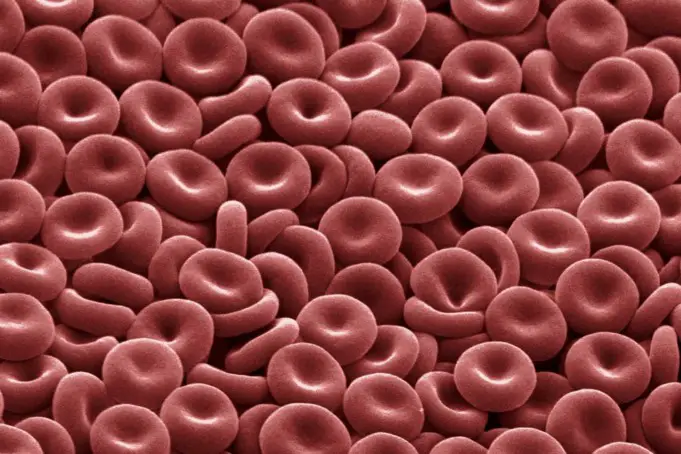Red blood cells are also known as red blood corpuscles, red cells, erythroid cells, haematids, or erythrocytes.
They are the most common types of blood cells in vertebrates, and their primary function is to carry oxygen to tissues of the body using the circulatory system as a means of transport. Red blood cells take up oxygen via the lungs or gills and release it into the tissues.
Red blood cell occurs in millions, and they give blood its characteristic red color. The red blood cells of a healthy mature adult are small, round, and biconcave, which makes it appear to be shaped like a dumbbell in profile.
The cytoplasm of erythrocytes contains hemoglobin, an iron-containing protein molecule that can bond with oxygen. The cell membrane is made up of lipids and proteins and lacks a nucleus.
Red blood cells in humans are very flexible. Their dumbbell shape allows it to squeeze through tight capillaries. Their lack of nucleus and other organelles enables it to have the maximum space in which it can accommodate hemoglobin.
The function of the erythrocyte is to carry oxygen from the lungs or gills to all the other body tissues and to carry carbon dioxide, a waste product of metabolism, to the lungs or gills where it is excreted.
Due to the lack of nucleus in the red cell, the amount of oxygen required by the cell for its metabolism is very low. The biconcave shape of red blood cells allows oxygen exchange at a constant rate over the broadest surface area.
Life Cycle of a Red Blood Cell
Red blood cells in humans are produced through a process known as erythropoiesis. The red cells develop from stem cells to mature red blood cells in approximately seven days.
Erythropoiesis is a 7-day process in which new erythrocytes are produced. These red blood cells are continuously produced in the red bone of large bones such as that in the pelvic region.
In embryos, the liver is the main site of red blood cell production. The hormone erythropoietin stimulates the production of these cells in the large bones, and the kidney synthesizes it.
These cells further develop into cells known as reticulocytes just before and after leaving the bone marrow.
Some of the materials required for the production of erythrocytes cells include:
- Iron
- Zinc
- B Vitamins
- Amino acids
- Lipids
- Copper
The matured red blood cells live in circulation in the bloodstream for about 100 to 200 days in healthy adults, while in infants, it lives for 80 to 90 days.
While in circulation, the red cells are continually moved by the blood pushing through the arteries, pulling through the veins, and the combination of the two actions as the squeeze through the capillaries. These cells are also recycled in the bone marrow.
At the end of their life cycle, they are removed from circulation. This life span is significantly reduced when the individual suffers from a chronic condition.
Macrophages selectively identify the aged red blood cells after they lose their plasma membrane. This leads to the subsequent removal by phagocytosis (engulfing and eliminating).
This process is known as eryptosis, the programmed death of red blood cells. This process of degradation coincides with erythropoiesis, thus balancing the total red blood cells in circulation.
Certain conditions can increase the rate of eryptosis. These include:
- Malaria
- Sepsis
- Wilson’s disease
- Sickle cell anemia
- Hemolytic uremic syndrome
- Beta-thalassemia
- Glucose-6-phosphate dehydrogenase
- Iron deficiency
Structure and Adaptive features of Red Blood Cells
Biconcave shape
One of the primary adaptations of the red blood cells is their general shape. Erythrocytes are typically shaped like a donut without a hole in the middle. This shape is a necessary adaptation that allows the cell to carry oxygen molecules effectively.
Also, red blood cells have been observed to be capable of reverting to this biconcave e shape after being exposed to external forces that cause them to endure deformations.
This ability to undergo such deformations has been attributed to their biconcave discoid structure, surface area to volume ratio, and other mechanical properties. Although erythrocytes have a very thin membrane, the membrane is consists of a bilayer of lipids.
This particular characteristic of red blood cells allows them to withstand forces that may otherwise cause deformations. However, the internal fluid matrix of the cell, as well as the bilayer lipid membrane, contributes to the viscoelastic properties of red blood cells, which in turn allows them to travel through smaller spaces.
Due to their viscoelastic characteristics, erythrocytes can squeeze through very thin capillaries to deliver oxygen and remove carbon dioxide.
Absence of Nucleus
Although the erythrocytes of animals such as birds and fish have inactive nuclei, red blood cells in humans and several other animals do not possess a nucleus. This permits the cells to contain more hemoglobin, the globin protein involved in the transportation of oxygen.
Unlike the other cells in the body, erythrocytes are made up of pigments known and hemoglobin. These are composed of four hemes, and they give the blood its red color.
The four hemes attach themselves to a single protein to form a polypeptide chain. It is this structure that makes it possible for the red cell to carry oxygen and transport it to other body cells.
Since the red blood cells do not have a nucleus and therefore do not reproduce/cell division, the absence of nucleus in the red cells reduces the total weight, which in turn allows for fast travel as they transport oxygen.
Absence of Mitochondria
The red blood cells, unlike other cells, do not possess mitochondria. As such, they rely on anaerobic respiration for the production of energy. They also do not have endoplasmic reticulum and therefore are not capable of synthesizing proteins as other cells do
Erythrocytes utilize the energy produced by anaerobic respiration as they circulate all the oxygen they carry to other cells that need it. This ensures that oxygen is not wasted in the process.
Because red cells lack mitochondria, they also lack the oxidative enzymes required for aerobic respiration.
Diseases of the Red Blood Cells
Diseases of the blood that involve red blood cells include:
Sickle-cell Disease
This is a life-long genetic disease that involved deformed red cells. This deformity results in abnormal hemoglobin molecules. When these molecules release their oxygen content in the tissues, they become insoluble.
The sickle-shaped erythrocytes are rigid and are less viscoelastic than that of a healthy individual. They can block blood vessels, damage tissues, and can cause pain.
Iron Deficiency Anemia
Iron is an essential component of hemoglobin in red blood cells. Iron deficiency occurs when there is insufficient dietary intake or absorption of iron.
Thalassemia
This is an inherited blood disorder that is characterized by the abnormal production of hemoglobin.
Pernicious Anemia
An auto-immune disease where insufficient amounts of hemoglobin are produced due to the lack of vitamin B.
Aplastic Anemia
A type of anemia where the bone marrow is unable to produce sufficient amounts of red blood cells.
Leukemia
A disease that impairs the bone marrows ability to produce red blood cells and platelets
Lymphoma
A condition that affects the functioning of the white blood cells
Red Blood Cell Count
A red blood cell count is a test that a doctor uses to find out how many red blood cells (RBCs) one has. It’s also known as an erythrocyte count. The number of RBCs an individual has can affect how much oxygen their tissues receive.
The following symptoms and complications can arise when the red blood cell count is too low or too high.
Symptoms of low red blood cell count include
- Shortness of breath
- Headaches
- Increased heart rate
- Dizziness and lightheadedness
- Pale skin
Symptoms of high red blood cell count include
- Shortness of breath
- Fatigue
- Tenderness in the palms of the hands or soles of the feet
- Itching skin
- Joint pain
- Difficulty sleeping
Checkout the White blood cell article as well.












